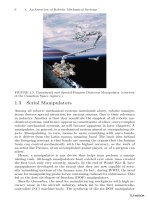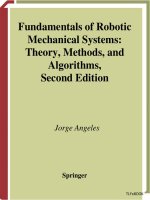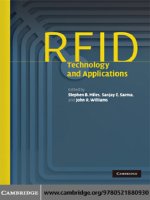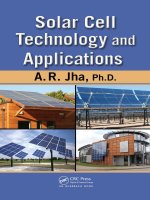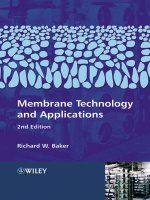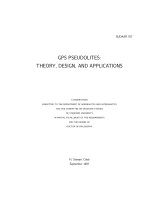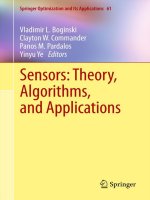computer systems theory, technology, and applications
Bạn đang xem bản rút gọn của tài liệu. Xem và tải ngay bản đầy đủ của tài liệu tại đây (2.97 MB, 357 trang )
Monographs in Computer Science
Editors
David Gries
Fred B. Schneider
This page intentionally left blank
Andrew Herbert
Karen Spa
¨
rck Jones
Editors
Computer Systems
Theory, Technology,
and Applications
A Tribute to Roger Needham
With 110 Illustrations
Andrew Herbert Karen Spa
¨
rck Jones
Microsoft Research Ltd. Computer Laboratory
Roger Needham Building University of Cambridge
7JJThomson Avenue JJ Thomson Avenue
Cambridge CB3 0FB Cambridge CB3 0FD
UK UK
Series Editors:
David Gries Fred B. Schneider
Department of Computer Science Department of Computer Science
The University of Georgia Cornell University
415 Boyd Graduate Studies 4115C Upson Hall
Research Center Ithaca, NY 14853-7501
Athens, GA 30602-7404 USA
USA
Library of Congress Cataloging-in-Publication Data
Herbert, A.J. (Andrew J.), 1954–
Computer systems: theory, technology, and applications/[edited by] Andrew J. Herbert,
Karen I.B. Spa
¨
rck Jones
p. cm. — (Monographs in computer science)
Includes bibliographical references.
ISBN 0-387-20170-X (alk. paper)
1. System design. 2. Computer science. I. Spa
¨
rck Jones, Karen I.B. II. Nee dham,
R.M. (Roger Michael) III. Title. IV. Series.
QA276.9.S88H45 2004
005.1′2—dc21 2003066215
ISBN 0-387-20170-X Printed on acid-free paper.
2004 Springer-Verlag New York, Inc.
All rights reserved. This work may not be translated or copied in whole or in part without
the written permission of the publisher (Springer-Verlag New York, Inc., 175 Fifth Avenue,
New York, NY 10010, USA), except for brief excerpts in connection with reviews or scholarly
analysis. Use in connection with any form of information storage and retrieval, electronic
adaptation, computer software, or by similar or dissimilar methodology now known or here-
after developed is forbidden.
The use in this publication of trade names, trademarks, service marks, and similar terms,
even if they are not identified as such, is not to be taken as an expression of opinion as to
whether or not they are subject to proprietary rights.
Printed in the United States of America. (SBA)
987654321 SPIN 10944769
Springer-Verlag is part of Springer Science+Business Media
springeronline.com
Roger Needham
1935 – 2003
This page intentionally left blank
Contents
Preface xi
Roger Needham: 50 + 5 Meeting Programme xiii
Contributors xv
Introduction: Roger Needham
Rick Rashid 1
1 On Access Control, Data Integration, and Their Languages
Martín Abadi 9
2 Protocol Analysis, Composability and Computation
Ross Anderson, Michael Bond 15
3 Access Control in Distributed Systems
Jean Bacon, Ken Moody 21
4 Implementing Condition Variables with Semaphores
Andrew D. Birrell 29
5 Clumps, Clusters and Classification
Christopher M. Bishop 39
6 How to Implement Unnecessary Mutexes
Mike Burrows 51
7 Bioware Languages
Luca Cardelli 59
8 The Economics of Open Systems
David D. Clark 67
9 From Universe to Global Internet
Jon Crowcroft 73
10 Needham-Schroeder Goes to Court
Dorothy E. Denning 77
11 The Design of Reliable Operating Systems
Peter Denning 79
12 An Historical Connection between Time-Sharing and Virtual Circuits
Sandy Fraser 85
13 On Cross-Platform Security
Li Gong 89
14 Distributed Computing Economics
Jim Gray 93
15 The Titan Influence
David Hartley 103
16 Middleware? Muddleware?
Andrew Herbert 109
17 Grand Challenges for Computing Research
viii Contents
Tony Hoare 117
18 Sentient Computing
Andy Hopper 125
19 Cyber Security in Open Systems
Anita Jones 133
20 Software Components: Only the Giants Survive
Butler W. Lampson 137
21 Security Protocols: Who Knows What Exactly?
Peter Landrock 147
22 Volume Rendering by Ray-Casting in Shear-Image Order
Hugh C. Lauer, Yin Wu, Vishal Bhatia, Larry Seiler 153
23 A Conceptual Authorization Model for Web Services
Paul J. Leach, Chris Kaler, Blair Dillaway, Praerit Garg,
Brian LaMacchia, Butler Lampson, John Manferdelli,
Rick Rashid, John Shewchuk, Dan Simon, Richard Ward 165
24 The Trouble with Standards
E. Stewart Lee 173
25 Novelty in the Nemesis Operating System
Ian Leslie 177
26 A Technology Transfer Retrospective
Roy Levin 185
27 An Optical LAN
Derek McAuley 195
28 What’s in a Name?
Robin Milner 205
29 The Cryptographic Role of the Cleaning Lady
Bob Morris 211
30 Real Time in a Real Operating System
Sape J. Mullender, Pierre G. Jansen 213
31 Zen and the Art of Research Management
John Naughton, Robert W. Taylor 223
32 The Descent of BAN
Lawrence C. Paulson 225
33 Brief Encounters
Brian Randell 229
34 Retrieval System Models: What’s New?
Stephen Robertson, Karen Spärck Jones 237
35 Slammer: An Urgent Wake-Up Call
Jerome H. Saltzer 243
36 Caching Trust Rather Than Content
M. Satyanarayanan 249
37 Least Privilege and More
Fred B. Schneider 253
38 Using Sharing to Simplify System Management
Michael D. Schroeder 259
Contents ix
39 An RSA-Related Number-Theoretic Surprise
Gustavus J. Simmons 269
40 Application-Private Networks
Jonathan M. Smith 273
41 Using the CORAL System to Discover Attacks on Security Protocols
Graham Steel, Alan Bundy, Ewen Denney 279
42 On the Role of Binding and Rate Adaptation in Packet Networks
David Tennenhouse 287
43 Technologies for Portable Computing
Chuck Thacker 295
44 Multiple Alternative Voting
David Wheeler 305
45 The Semiotics of Umbrellas
John Wilkes 311
46 Computers for Specialized Application Areas
Maurice Wilkes 317
Computer Security?
Roger Needham 319
Roger Needham: Publications
Karen Spärck Jones 327
This page intentionally left blank
Preface
Roger learnt that he was seriously ill late in December 2002. When he heard this,
Rick Rashid, Microsoft Senior Vice-President for Research, suggested that there
should be some occasion to mark Roger’s contribution to the field, and an asso-
ciated publication.
In response, we proposed a one-day meeting with both technical talks and a
more personal session about Roger, with the presentation of a volume of papers
from Roger’s many technical colleagues as the key element.
There was not much time to prepare the volume. So we asked for short pa-
pers on any technical topic of each contributor’s choosing likely to be of interest
to Roger. The papers could be on an area of current research, a conjecture about
the future, or an historical reflection. They had to be delivered in four weeks. We
much appreciated the rapid and enthusiastic responses to our invitation, and were
delighted with the range of topics covered and their technical interest. We were
also grateful, as each editor reviewed all the papers, for the positive spirit with
which our comments and suggestions were received.
The meeting itself, ‘Roger Needham: 50 and 5,’ marking Roger’s fifty years
in Cambridge and five at Microsoft Research, took place on February 17th,
2003. The programme is given, for reference, following this Preface. The entire
proceedings were recorded, publicly available at:
/>We would like to thank all those who wrote for the volume, and those who spoke
at the meeting.
We know that Roger was very touched by how many came to the meeting,
some from far away, by how many wrote for the volume and in doing so re-
sponded to his interests, by the references to his work in the technical talks, and
by the accounts of his roles and contributions in the presentation session. At the
end of the meeting he said:
The first thing to say is thank you very much—which is sort of obvious.
The next thing I want to say is one or two words about what I’ve done and
what my subject is. In many sorts of engineering the theoretical background
is obvious: it’s continuous mathematics which comes from the 18th century.
In computing there is a theoretical background and it’s not obvious but it had
to be invented, and people in the theoretical part of our subject have devoted
themselves to inventing it—which is fine because you can’t expect it to hap-
pen by itself and you can’t go and build computer systems with any complex-
ity at all without some formalised understanding to fall back on.
xii Preface
It is an odd thing that in my career I have contributed one or two bits to that,
but that’s basically not what I’m about.
I have the greatest respect for the people who build the theoretical underpin-
nings of our subject, and I wish them every success because it will enable the
people who want to get on and make things to do it better and to do it more
quickly and to do it with less mistakes—and all of this is good: but at the end
of the day I am a engineer—
and so saying, he put on his engineer’s hard hat. He died less than two weeks
later, on March 1st.
Roger’s last major talk was his Clifford Paterson Lecture ‘Computer secu-
rity?’ at The Royal Society in November 2002. We have included its text, which
is also posthumously published in the Society’s Philosophical Transactions,as
the last paper in the volume, along with a complete list of Roger’s publications.
We have used the classic Needham-Schroeder authentication protocol as the
cover design.
The papers in this volume are as they originally appeared for the meeting,
apart from some minor corrections and some small modifications, necessary in
the circumstances, to specific references to Roger.
These papers address issues over the whole area of computer systems, from
hardware through operating systems and middleware to applications, with their
languages and their implementations, and from devices to global networks; also
from many points of view, from designers to users, with lessons from the past or
concerns for the future. Collectively, they illustrate what it means to be a com-
puter system.
Acknowledgements
We are very grateful to Microsoft for supporting the celebration meeting itself,
producing the volume in its original form, and for further supporting the prepara-
tion of the volume for formal publication.
We are also grateful to Professor Fred Schneider for facilitating the Springer
publication and to Tammy Monteith for her work on formatting the material.
Andrew Herbert, Karen Spärck Jones
Roger Needham: 50 + 5
Meeting Programme
Time
Title Presenter
11 am Introduction Andrew Herbert,
Microsoft Research
TECHNICAL TALKS
11.05 am Location Aware Computing Andy Hopper,
Cambridge University
11.30 am How Software Components Grew Up and
Conquered the World
Butler Lampson,
Microsoft Research
12 noon Thoughts on Network Protocol Engineering Jonathan Smith,
University of Pennsylvania
12.30 pm Lunch
1.30 pm Online Science: Putting All Science Data
Online and Putting Analysis Tools Online.
Jim Gray,
Microsoft Research
2 pm Logics and Languages for Access Control Martin Abadi,
UCSC
2.30 pm Protocol Analysis, Composability and
Computation
Ross Anderson,
Cambridge University
3.00 pm Coffee
3.30 pm Information and Classification Karen Spärck Jones,
Cambridge University
Clumps, Clusters and Classification Christopher Bishop,
Microsoft Research
IN HONOUR OF ROGER NEEDHAM
4.10 pm Early Days Maurice Wilkes,
Cambridge University
4.20 pm Head of Department, Computer Laboratory Ian Leslie,
Cambridge University
4.30 pm PARC/DEC-SRC Activities Mike Schroeder,
Microsoft Research
4.40 pm Pro Vice-Chancellor, Public Service Alec Broers,
Cambridge University
4.45 pm Microsoft Managing Director Rick Rashid,
Microsoft Research
4.55 pm Presentation Andrew Herbert
Microsoft Research
5pm Reception
This page intentionally left blank
Contributors
Martín Abadi
University of California, Santa Cruz,
CA, USA
Ross Anderson
University of Cambridge, England
Jean Bacon
University of Cambridge, England
Andrew Birrell
Microsoft Research—Silicon Valley,
CA, USA
Christopher Bishop
Microsoft Research Ltd, Cambridge,
England
Michael Bond
University of Cambridge, England
Alan Bundy
University of Edinburgh, Scotland
Mike Burrows
Google Research, Mountain View, CA,
USA
Luca Cardelli
Microsoft Research Ltd, Cambridge,
Englan
d
David Clark
MIT, Cambridge, MA, USA
John Crowcroft
University of Cambridge, England
Ewen Denney
QSS Group Inc, NASA, Moffet Field,
CA, USA
Dorothy Denning
Naval Postgraduate School, Monterey,
CA, USA
Peter Denning
Naval Postgraduate School, Monterey,
CA, USA
Sandy Fraser
Bernardsville, NJ, USA
Li Gong
Sun Microsystems, Santa Clara, CA,
USA
Jim Gray
Microsoft Research, San Francisco,
CA, USA
David Hartley
Cambridge, England
Andrew Herbert
Microsoft Research Ltd, Cambridge,
England
Tony Hoare
Microsoft Research Ltd, Cambridge,
England
Andy Hopper
University of Cambridge, England
xvi Contributors
Pierre Jansen
University of Twente, Enschede,
The Netherlands
Anita Jones
University of Virginia, Charlottesville,
VA, USA
Butler Lampson
Microsoft Research, Redmond, WA,
USA
Peter Landrock,
Århus University, Denmark
Hugh Lauer
TeraRecon, Inc., Concord, MA, USA
Paul Leach
Microsoft Corporation, Redmond, WA,
USA
Stewart Lee
Orillia, Ontario, Canada
Ian Leslie
University of Cambridge, England
Roy Levin
Microsoft Research—Silicon Valley,
CA, USA
Derek McAuley
Intel Research, Cambridge, England
Robin Milner
University of Cambridge, England
Ken Moody
University of Cambridge, England
Bob Morris
Dartmouth College, Hanover, NH,
USA
Sape Mullender
Lucent Technologies, Murray Hill, NJ,
USA
John Naughton
Open University, Milton Keynes, Eng-
land
Lawrence Paulson
University of Cambridge, England
Brian Randell
University of Newcastle, England
Rick Rashid,
Microsoft Research, Redmond, WA,
USA
Stephen Robertson
Microsoft Research Ltd, Cambridge,
England
Jerome Saltzer
MIT, Cambridge, MA, USA
Mahadev Satyanarayanan
Carnegie Mellon University, Pitts-
burgh, PA, USA
Fred Schneider
Cornell University, Ithaca, NY, USA
Michael Schroeder
Microsoft Research—Silicon Valley,
CA, USA
Gustavus Simmons
Sandia Park, NM, USA
Jonathan Smith
University of Pennsylvania,
Philadelphia, PA, USA
Karen Spärck Jones
University of Cambridge, England
Contributors xvii
Graham Steel
University of Edinburgh, Scotland
Robert Taylor
Woodside, California, USA
David Tennenhouse
Intel Research, Santa Clara, CA, USA
Chuck Thacker
Microsoft Corporation, Redmond, WA,
USA
David Wheeler
University of Cambridge, England
John Wilkes
HPLabs,PaloAlto,CA,USA
Maurice Wilkes
University of Cambridge, England
This page intentionally left blank
Introduction: Roger Needham
1
Rick Rashid
Senior Vice President, Microsoft Research
I first encountered Roger Needham almost 20 years ago while lecturing in an
advanced course on distributed systems being held in Glasgow during the sum-
mer of 1983. I must admit that I felt just a bit out of place lecturing alongside the
likes of Gerald Le Lann, Jim Mitchell and Roger Needham. Roger had become
head of Cambridge University’s fabled Computer Laboratory just three years
earlier, about the same time I had received my Ph.D.
When I heard Roger lecture for the first time, I was taken aback by his re-
markable and very unusual speaking style. I’ve since seen it described in the
press as “deliberate and thoughtful,” and it is all of that. Listening to a lecture in
computer science can sometimes make you feel as though you are chasing after
the words trying to piece together the speaker’s meaning. When Roger spoke I
found myself hanging on each word, wondering with great anticipation what
would come next. The wait was usually worthwhile. That summer in 1983 I dis-
covered to my delight Roger’s keen insight, dry wit and ability to turn the Eng-
lish language into his personal plaything:
An improvement is something your program will not work with and a bug fix
is something it will not work without.
Looking back, I still find it hard to believe that 20 years later I would be run-
ning a large research organization for Microsoft and would have the privilege of
working with Roger on a daily basis as Managing Director of our Cambridge
research laboratory. It has been quite a journey.
Early career
I’ve heard the story told that while studying for his Ph.D., Roger lived in a cara-
van with his wife Karen Spärck Jones, with whom he also collaborated on sev-
1 This text is as written before Roger’s death, except for changes in the last paragraph.
2Rashid
eral papers. The reason for their unorthodox living arrangements was that while
completing his Ph.D., Roger and Karen also undertook the building of their own
house. Despite this rather strenuous side occupation, Roger completed his Ph.D.,
at Cambridge in 1961. This was on automatic classification and information re-
trieval, exciting, new and interdisciplinary areas. At the time, Roger was working
with the Cambridge Language Research Unit, which was investigating machine
translation, automated retrieval, and the like. He joined the University’s Mathe-
matical Laboratory—what is now known as the Computer Laboratory—in 1962,
as a Senior Assistant in Research.
Although his Ph.D. was on an applications topic, Roger’s career has been
that of a classic—almost prototypical—“systems” computer scientist. It is hard
to pin him down to a single area. Roger has made significant contributions to
areas such as operating systems, networking, distributed systems, computer secu-
rity and multimedia. In an interview for SIGSoft’s Software Engineering Notes
published in January 2001, Roger is quoted as saying:
I regard myself as a systems person, not an OS person, nor a communications
systems person. I think all three systems require the same kind of skills.
During his career Roger has had a knack for apparently being at the right
place at the right time, working with the right collaborators and hitting on the
right idea. Roger is fond of saying,
Serendipity is looking for a needle in a haystack and finding the farmer’s
daughter.
The reality is that his consistent contributions have had nothing to do with
serendipity but rather his personal talents and ability to draw to himself talented
people and find ways to inspire and motivate them.
The first major system Roger worked on following his Ph.D. was TITAN.
The Laboratory, under Maurice Wilkes, was providing the software for hardware
built by Ferranti (subsequently ICT/ICL). TITAN was the earliest computer sys-
tem to employ cache memory, and its operating system was the first multi-access
system written outside the US to go into public use. Roger first worked with
David Wheeler on design automation, and then became involved in building the
operating system. One of Roger’s enduring innovations was the use of a one-way
function to protect its password file—something virtually every modern com-
puter system does today. The TITAN file system also introduced the notion of
full backup and restore and the ability to do incremental backups.
Computing in the 1960s and early 1970s was a “full contact sport.” In keep-
ing with his “systems” image, Roger was not above doing anything that might be
required to keep his operating system running. In addition to developing
TITAN’s software, he enjoys telling the story of the miserable day he sat in an
air conditioning unit pouring water from a bucket over a pile of bricks to cool the
system and keep it running for users.
As a member of staff, Roger also began to teach, initially for the Diploma
and later, when Cambridge accepted Computer Science as a degree subject, to
Introduction 3
undergraduates; and he began to take Ph.D. students, now to be met round the
world.
CAP, Rings and the Cambridge Model Distributed
System
Building on lessons learned from TITAN, in the late 1960s Roger began to con-
centrate on protection—providing fine-grained access control to resources be-
tween users, between users and the operating system, and between operating
system modules. From the early 1970s he worked with Maurice Wilkes and
David Wheeler on the design and construction of the CAP computer, an experi-
mental machine with memory protection based on capabilities implemented in
hardware. Once the machine was running in 1975, Roger then led the develop-
ment of the machine’s operating system and was responsible for many innova-
tions in computer security. The CAP project received a British Computer Society
Technical Award in 1977. As the Internet moves toward adoption of a common
web services infrastructure, there is renewed interest in capability based access
control today.
Working with Maurice Wilkes, David Wheeler, Andy Hopper and others,
Roger was also involved in the construction of the Cambridge Ring (1974) and
its successor the Cambridge Fast Ring (1980). The 10-megabit-per-second Cam-
bridge Ring put the Computer Laboratory at the forefront of high-speed local-
area networking and distributed computing research. The Cambridge Fast Ring
ran at 100 megabits per second—still the typical speed of local computer net-
works more than 20 years later—and helped to inspire the creation of the ATM
switching networks in use today.
The software developed to run on top of the Cambridge Ring was no less re-
markable than the hardware. The Cambridge Model Distributed System on
which Roger worked with Andrew Herbert and others was an innovative distrib-
uted software environment exploiting the Ring. It included computing compo-
nents such as a Processor Bank, File Server, Authentication Server, Boot Server,
etc., and was an early model for what we would today call “thin client comput-
ing.”
This line of work on distributed systems was taken further in the 1980s in
work with Ian Leslie, David Tennenhouse and others on the Universe and Uni-
son projects, where independent Cambridge Rings that sat at several UK sites
were interconnected by satellite (Universe) and high-speed point-to-point links
(Unison) to demonstrate wide-area distributed computing. Both rings were used
to do real-time voice and video applications (the Cambridge “Island” project)—
another “first.”
There were several commercial and academic deployments of Cambridge
Rings spun out from the Computer Laboratory. It is believed that a derivative of
4Rashid
the Cambridge Ring still runs part of the railway signalling system at London’s
Liverpool Street Station!
Head of Department, Computer Laboratory
Roger had been promoted to Reader in Computer Systems in 1973, and was
made Professor in 1981. When Maurice Wilkes retired in 1980, Roger became
Head of Department. In addition to his personal scientific achievements, Roger
oversaw the growth and maturation of Cambridge University’s Computer Labo-
ratory during an important part of its history. When he took over as Head of De-
partment, the Laboratory had a teaching and research staff of 10 and just over 40
Ph.D. students. Ten years later, in 1990, the teaching and research staff had
grown to 27, and the number of Ph.D. students had more than doubled. Roger is
quoted as referring to this as the Laboratory’s
“halcyon days”—an expanding Laboratory and no external interference.
Though the Laboratory’s strength was in systems, and Roger himself was a
“systems” scientist, he encouraged new areas to develop, for example, formal
methods, and language and information processing. One topic of research Roger
particularly promoted at Cambridge was the intersection of multimedia systems
and networking. As a result, Cambridge became one of the first research labora-
tories in the world where teleconferencing and video mail became regular tools
for research.
Roger continued in the 1980s and 90s to be interested in all aspects of com-
puter systems, but was especially concerned with security. He participated in
every one of the ACM Symposia on Operating Systems Principles, and is be-
lieved to be the only person to have achieved a 100% attendance record. With
Ross Anderson and others he significantly developed and expanded Cambridge
research into computer security. He took an active role in creating a security
programme at the Newton Institute and hosting an annual Security Protocols
Workshop, which he continues to do from Microsoft. He has recently combined
his intellectual and (left wing) political interests as a Trustee of the Foundation
for Information Policy Research. He has also emphasised, in a related spirit, in
his 2002 Saul Gorn Lecture at the University of Pennsylvania and Clifford Pater-
son Lecture at the Royal Society, that doing system security properly is as much
about people as about machines.
Referring to Roger’s impact on the Computer Laboratory on the occasion of
his Honorary Doctorate from the University of Twente in 1996, Sape Mullender
wrote:
Needham works as a catalyst. When he is around, systems research gets more
focus and more vision. He brings out the best in the people around him. This
helps to explain why, for as long as I can remember, the Cambridge Univer-
Introduction 5
sity Computer Laboratory has been among the best systems research labora-
tories in the world. This is recognized even by Americans, although their na-
tional pride doesn’t always allow them to admit that MIT, Stanford, Berkeley,
Cornell, and the rest of them, have something to learn abroad, in Cambridge.
Public service
Roger began his public service career in the 1960s as a member of the Science
Research Council’s Computing Science Committee. His public service activities
ramified in the 80s and 90s, extending into all kinds of government and other
boards and committees. He has said he found some of them fun—the Alvey
Committee, for example, had the opportunity to drive a large national computing
research programme; some were interesting, like the Research Councils’ Indi-
vidual Merit Promotion Panel; and some were keeping a particular show on the
road. He has felt the obligation to do these things; he has also enjoyed learning
and deploying the skills required to do them effectively. His most recent chal-
lenge has been chairing a Royal Society Working Party on intellectual property.
Roger was able to exploit these skills, and what he had learnt about the Uni-
versity while Head of Department, as Pro Vice-Chancellor from 1996–1998,
with a remit on the research side of the University’s operations. This had all
kinds of interesting side-effects, like chairing Electors to Chairs across the Uni-
versity and so getting snapshots of what’s hot in pharmacology, or economic
history, or Spanish.
The list of awards and honors Roger has received for both his personal
achievements and his contributions to Cambridge and to the field is impressive,
including being named Fellow of the British Computer Society, Fellow of the
Royal Society, Fellow of the Royal Academy of Engineering and Fellow of the
ACM. Roger was also awarded the CBE (Commander of the Order of the British
Empire) for his services to Computer Science in 2001.
Working with industry
One constant of Roger’s career has been his consistent connection to industrial
research and development. He was a Director of Cambridge Consultants in the
1960s, and for ten years on the Board of Computer Technology Ltd. He was a
consultant to Xerox PARC from 1977 to 1984 and to Digital’s System Research
Center from 1984 to 1997. From 1995 to 1997 he was a member of the interna-
tional advisory board for Hitachi’s Advanced Research Laboratory, and on the
Board of UKERNA from its inception until 1998.
Spin-offs from the Computer Laboratory had begun in the 1970s, contribut-
ing to the “Cambridge Phenomenon.” When Roger was Head of Department, he
6Rashid
fostered these connections, welcoming the idea of a Laboratory Supporters Club
and becoming one of the “Godfathers” for Cambridge entrepreneurs.
Some of Roger’s most famous papers were conceived during consulting trips
and sabbaticals working at industrial research laboratories. The secure authenti-
cation system he described in his 1978 paper with Mike Schroeder of Xerox
PARC became the basis for systems such as Kerberos—still in use today—and
represented a turning point in distributed system security research. Working with
Digital Equipment’s Mike Burrows and Martin Abadi, he created the first for-
malism for the investigation of security protocols to come into wide use (also
called the BAN logic, named for its authors). Roger also made contributions to
Xerox’s Grapevine project and Digital’s AutoNet project.
Roger valued his longstanding connections with these company research cen-
tres. He was also able to observe the business of running a research centre—
how, and also how not, to—at first hand.
In 1995 Roger was asked in an interview how he viewed the relationship be-
tween academic work and industrial work in computer science:
If there wasn’t an industry concerned with making and using computers the
subject wouldn’t exist. It’s not like physics—physics was made by God, but
computer science was made by man. It’s there because the industry’s there.
I didn’t realize it at the time, but I would soon become the beneficiary of
Roger’s positive attitude toward working with industry.
By the mid 90s, too, Roger was finding university life, squeezed between a
rampant audit culture and a lack of money, less and less satisfying. Doing some-
thing new without either of these features, and with positive advantages of its
own, looked very attractive.
Microsoft Research, Cambridge
My personal history intersected again with Roger’s almost 14 years after my first
meeting with him in 1983. In 1991 I left Carnegie Mellon University, where I
had been teaching for 12 years, and joined Microsoft to start its basic research
laboratory: Microsoft Research. From the beginning, Nathan Myhrvold, who had
hired me as the first lab director, had contemplated creating a laboratory in
Europe to complement the one we were building in the United States. For the
first 5 years of Microsoft Research’s growth our Redmond facility was small
enough that our first priority was to build it up to critical mass. By 1996 we had
grown to over 100 researchers, and it was time to consider expanding outside the
US.
It was in the fall of 1996 as we were considering European expansion that we
learned through the grapevine that Roger Needham was willing to consider tak-
ing the position of director of a new lab. When I first heard the news I was tre-
